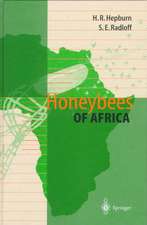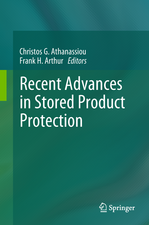Entomovectoring for Precision Biocontrol and Enhanced Pollination of Crops
Editat de Guy Smagghe, Otto Boecking, Bettina Maccagnani, Marika Mänd, Peter G. Kevanen Limba Engleză Paperback – 26 aug 2021
| Toate formatele și edițiile | Preț | Express |
|---|---|---|
| Paperback (1) | 934.57 lei 38-44 zile | |
| Springer International Publishing – 26 aug 2021 | 934.57 lei 38-44 zile | |
| Hardback (1) | 946.48 lei 38-44 zile | |
| Springer International Publishing – 30 iun 2020 | 946.48 lei 38-44 zile |
Preț: 934.57 lei
Preț vechi: 1229.71 lei
-24% Nou
Puncte Express: 1402
Preț estimativ în valută:
178.89€ • 194.38$ • 150.36£
178.89€ • 194.38$ • 150.36£
Carte tipărită la comandă
Livrare economică 16-22 aprilie
Preluare comenzi: 021 569.72.76
Specificații
ISBN-13: 9783030189198
ISBN-10: 3030189198
Pagini: 277
Ilustrații: X, 277 p. 102 illus., 78 illus. in color.
Dimensiuni: 155 x 235 mm
Ediția:1st ed. 2020
Editura: Springer International Publishing
Colecția Springer
Locul publicării:Cham, Switzerland
ISBN-10: 3030189198
Pagini: 277
Ilustrații: X, 277 p. 102 illus., 78 illus. in color.
Dimensiuni: 155 x 235 mm
Ediția:1st ed. 2020
Editura: Springer International Publishing
Colecția Springer
Locul publicării:Cham, Switzerland
Cuprins
1.Agroecosystem design supports the activity of pollinator networks.- 2. Ecological Intensification: Managing Biocomplexity and Biodiversity in Agriculture through Pollinators, Pollination and Deploying Biocontrol Agents against Crop and Pollinator Diseases, Pests, and Parasites.- 3. Bee pollination of crops: a natural and cost-free ecological service.- 4. Solitary bees as pollinators.- 5. Bumble bees and entomovectoring in open field conditions.- 6. Dispensers for entomovectoring: for every bee another type?.- 7. Cases on entomovectoring in the greenhouse and open field.- 8. A case study: Use of Prestop® Mix biofungicide in entomovectoring on apple against storage rot diseases.- 9. Threat of Drosophila suzukii as an invasive species and the potential of entomovectoring.- 10.The potential of bee vectoring in coffee in Brazil.- 11. Using bumblebees (Bombus terrestris) as bioagent vectors to control Sclerotinia head rot on sunflower in Serbia.- 12. Advances in the implementation of Beevector Technologi in Colombia: Strawberry case (Fragaria X ananassa).- 13-Making a pest beneficial: Fungus gnats [Bradysia impatiens (Diptera: Sciaridea)] as potential vectors of microbial control agents to suppress pathogens they also spread.- 14. Regulatory processes surrounding the risk assessment of microbial pesticides for pollinators.- 15. Flying Doctors for a better quality in fruit production.
Notă biografică
Prof. Guy Smagghe, Ghent University, Department of Crop Protection, Ghent, Belgium
Dr. Otto Boecking, Institut für Bienenkunde Celle, Celle, Germany
Bettina Maccagnani Ph.D., Agriculture and Environment Center, “Giorgio Nicoli”, CREVALCORE, Italy
Marika Mänd, Estonian University of Life Sciences, Department Plant Protection,Tartu, Estonia
Prof. Dr. Peter G. Kevan, University of Guelph, School of Environmental Sciences, 5Guelph, Canada
Textul de pe ultima copertă
This book examines entomovectoring, which employs crop pollinators to spread biocontrol protections against plant pathogens. The book describes research and development of the process, also known as apivectoring and beevectoring, for use both in pollination and in the delivery of biocontrol agents against crop and pollinator diseases, pests, and parasites.
The opening chapters show how design of agrosystems can support the activity of pollinator networks, and describe bee pollination as a natural and cost-free ecological service. Individual chapters cover bumble bees and solitary bees as pollinators.
The book outlines ways that entomovectoring can be used to increase biocomplexity and biodiversity in agriculture. Also included is a chapter on the threat of Drosophila suzukii, an invasive fruit fly that infests ripening fruit, and the prospect of improved control using entomovectoring. Another chapter discusses the prospect of using a species of fungus gnat as a potential vector of microbial control agents, to suppress pathogens that they also spread. A wide variety of crops are covered, including apples, strawberries, coffee, and sunflowers.
The book describes studies on use of entomovectoring in both open fields and greenhouse settings. Another case study reviews the use of a commercial biofungicide via entomovectoring, to combat storage rot diseases in apples. Coverage also includes Flying Doctors, a precision pollination system that uses pre-collected pollen delivered by bumble bees to replace artificial pollination via dusting or phytohormones.
Entomovectoring for Precision Biocontrol and Enhanced Pollination of Crops benefits graduate-level students in agriculture, plant pathology and entomology, as well as academics, researchers, working horticulturists and apiculturists, and those involved in formulating agricultural policy and regulations.
The opening chapters show how design of agrosystems can support the activity of pollinator networks, and describe bee pollination as a natural and cost-free ecological service. Individual chapters cover bumble bees and solitary bees as pollinators.
The book outlines ways that entomovectoring can be used to increase biocomplexity and biodiversity in agriculture. Also included is a chapter on the threat of Drosophila suzukii, an invasive fruit fly that infests ripening fruit, and the prospect of improved control using entomovectoring. Another chapter discusses the prospect of using a species of fungus gnat as a potential vector of microbial control agents, to suppress pathogens that they also spread. A wide variety of crops are covered, including apples, strawberries, coffee, and sunflowers.
The book describes studies on use of entomovectoring in both open fields and greenhouse settings. Another case study reviews the use of a commercial biofungicide via entomovectoring, to combat storage rot diseases in apples. Coverage also includes Flying Doctors, a precision pollination system that uses pre-collected pollen delivered by bumble bees to replace artificial pollination via dusting or phytohormones.
Entomovectoring for Precision Biocontrol and Enhanced Pollination of Crops benefits graduate-level students in agriculture, plant pathology and entomology, as well as academics, researchers, working horticulturists and apiculturists, and those involved in formulating agricultural policy and regulations.
Caracteristici
Describes uses of pollinators to protect against plant and insect pathogens Reviews case studies examining a variety of vectors, crops, and settings Analyzes risk assessment and regulatory processes for























